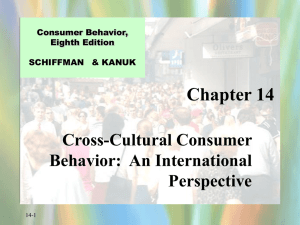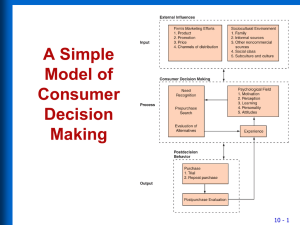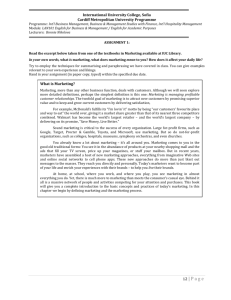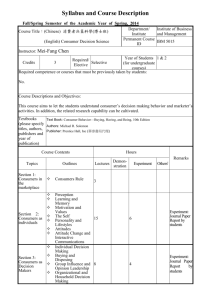File - e-education
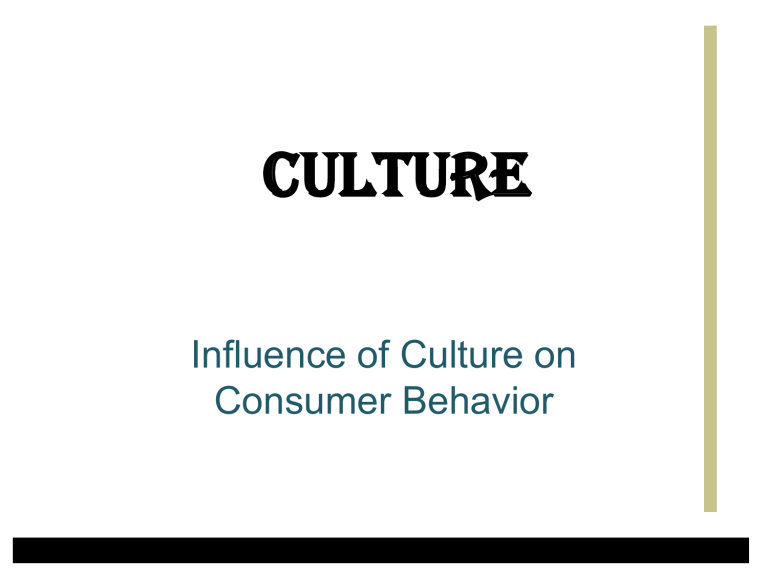
Culture
Influence of Culture on
Consumer Behavior
Culture
The sum total of learned beliefs, values, and customs that serve to regulate the consumer behavior of members of a particular society.
2
A Theoretical Model of Culture’s Influence on Behavior
3
The Invisible Hand of Culture
Each individual perceives the world through his own cultural lens
Culture Satisfies Needs
• Food and Clothing
• Needs vs. Luxury
In Terms of “Culture,” Do You Consider This Product to
Be a “Good Morning” Beverage? Why or Why Not?
6
Culture Is Learned
Issues
• Enculturation and acculturation
• Language and symbols
• Ritual
• Sharing of culture
• Enculturation
– The learning of one’s own culture
• Acculturation
– The learning of a new or foreign culture
7
Issues
Culture Is Learned
• Enculturation and acculturation
• Language and symbols
• Ritual
• Sharing of culture
• Without a common language ,shared meaning could not exist
• Marketers must choose appropriate symbols in advertising
• Marketers can use
“known” symbols for associations
8
Culture Is Learned
Issues
• Enculturation and acculturation
• Language and symbols
• Ritual
• Sharing of culture
• A ritual is a type of symbolic activity consisting of a series of steps
• Rituals extend over the human life cycle
• Marketers realize that rituals often involve products (artifacts)
9
Selected Rituals and Associated Artifacts
SELECTED RITUALS
Wedding
Birth of child
Birthday
50th Wedding anniversary
Graduation
Valentine’s Day
New Year’s Eve
TYPICAL ARTIFACTS
White gown (something old, something new, something borrowed, something blue)
U.S. Savings Bond, silver baby spoon
Card, present, cake with candles
Catered party, card and gift, display of photos of the couple’s life together
Pen, U.S. Savings Bond, card, wristwatch
Candy, card, flowers
Champagne, party, fancy dress
10
Culture Is Learned
Issues
• Enculturation and acculturation
• Language and symbols
• Ritual
• Sharing of Culture
• To be a cultural characteristic, a belief, value, or practice must be shared by a significant portion of the society
• Culture is transferred through family, schools, houses of worship, and media
11
Culture is Dynamic
• Evolves because it fills needs
• Certain factors change culture
– Technology
– Population shifts
– Resource shortages
– Wars
– Changing values
– Customs from other countries
The Measurement of Culture
• Content Analysis
• Consumer Fieldwork
• Value Measurement
Instruments
13
Content
Analysis
A method for systematically analyzing the content of verbal and/or pictorial communication. The method is frequently used to determine prevailing social values of a society.
14
Which Cultural Value
Is Portrayed, and How So?
15
Which Cultural Value
Is This Ad Stressing, and How So?
16
Consumer Fieldwork
• Field Observation
– Natural setting
– Subject unaware
– Focus on observation of behavior
• Participant Observation
American Core Values
Criteria for Value Selection
• The value must be pervasive.
• The value must be enduring.
• The value must be consumer-related.
18
American Core Values
Achievement and success
Activity
Material comfort
Individualism
Efficiency and practicality
Progress
Freedom
External conformity
Humanitarianism Youthfulness
Fitness and health
19
Scale to Measure Attitude
Toward Helping Others
Attitude toward helping others (AHO)
• People should be willing to help others who are less fortunate
• Helping troubled people with their problems is very important to me
• People should be more charitable toward others in society
• People in need should receive support from others
Toward a Shopping Culture
• Is shopping what we do to create value in our lives?
• The younger generation is shopping more
• This has an effect on credit card debt
21
Subcultures and Consumer
Behavior
Subculture
A distinct cultural group that exists as an identifiable segment within a larger, more complex society.
Relationship Between Culture and
Subculture
24
Examples of Major Sub-cultural Categories
CATEGORIES
Nationality
Religion
Geographic region
Race
Age
Gender
Occupation
Social class
EXAMPLES
Greek, Italian, Russian
Catholic, Hindu, Mormon
Eastern, Southern, Southwestern
African American, Asian, Caucasian
Teenagers, Xers, elderly
Female, male
Bus driver, cook, scientist
Lower, middle, upper
25
Subcultures
• Nationality Subcultures
• Religious Subcultures
• Regional Subcultures
• Racial Subcultures
• Age Subcultures
• Gender Subcultures
• Occupation Subcultures
• Social class Subcultures
26
Issues in Understanding Gender as a
Subculture
• Gender Roles and Consumer Behavior
– Masculine vs. Feminine Traits
• Consumer Products and Gender Roles
• Women as depicted in Media
27
Working Women
• Segments of ALL women
– Stay-at-home
– Plan-to-work
– Just-a-job working
– Career-oriented working
Subcultural
Interaction
Marketers should strive to understand how multiple subcultural memberships jointly influence consumers behavior
29
Cross-Cultural Consumer
Behavior:
An International
Perspective
The Imperative to Be Multinational
• Global Trade
Agreements
– EU
– NAFTA
• Winning Emerging
Markets
• Acquiring Exposure to
Other Cultures
• Country-of-origin Effects
31
The Best Global Brands
1. Coca-Cola
2. IBM
3. Microsoft
4. GE
5. Nokia
6. Toyota
7. Intel
8.
McDonald’s
9. Disney
10.Google
32
Country of Origin Effects:
Positive
• Many consumers may take into consideration the country of origin of a product.
• Country-of-origin commonly:
– France = wine, fashion, perfume
– Italy = pasta, designer clothing, furniture, shoes, and sports cars
– Japan = cameras and consumer electronics
– Germany = cars, tools, and machinery
33
Country of Origin Effects:
Negative
• Some consumers have animosity toward a country
– People’s Republic of China has some animosity to Japan
– Jewish consumers avoid German products
– New Zealand and Australian consumers boycott French products
34
Why Do Most Global
Airlines Stress Pampering
Business Travelers in Their Ads?
35
Upscale International Business
Travelers Share Much in Common.
36
Other Country-of-Origin Effects
• Mexican study uncovered:
– Country-of-design (COD)
– Country-of-assembly (COA)
– Country-of-parts (COP)
37
Conceptual Model of COD and COM
Cross-Cultural
Consumer
Analysis
The effort to determine to what extent the consumers of two or more nations are similar or different.
39
Cross-Cultural Consumer Analysis
Issues
• Similarities and differences among people
• The growing global middle class
• The global teen market
• Acculturation
40
• The greater the similarity between nations, the more feasible to use relatively similar marketing strategies
• Marketers often speak to the same “types” of consumers globally
Comparisons of Chinese and American
Cultural Traits
• Chinese Cultural Traits
• Centered on Confucian doctrine
• Submissive to authority
• Ancestor worship
• Values a person’s duty to family and state
• American Cultural Traits
• Individual centered
• Emphasis on selfreliance
• Primary faith in rationalism
• Values individual personality
41
Cross-Cultural Consumer Analysis
Issues
• Similarities and differences among people
• The growing global middle class
• The global teen market
• Acculturation
• Growing in Asia, South
America, and Eastern
Europe
• Marketers should focus on these markets
42
Cross-Cultural Consumer Analysis
Issues
• Similarities and differences among people
• The growing global middle class
• The global teen market
• Acculturation
• There has been growth in an affluent global teenage and young adult market.
• They appear to have similar interests, desires, and consumption behavior no matter where they live.
43
Cross-Cultural Consumer Analysis
Issues
• Similarities and differences among people
• The growing global middle class
• The global teen market
• Acculturation
• Marketers must learn everything that is relevant about the usage of their product and product categories in foreign countries
44
Research Issues in Cross-Cultural Analysis
FACTORS
Differences in language and meaning
EXAMPLES
Words or concepts may not mean the same in two different countries.
Differences in market segmentation opportunities
The income, social class, age, and sex of target customers may differ dramatically in two different countries.
Differences in consumption patterns Two countries may differ substantially in the level of consumption or use of products or services.
Differences in the perceived benefits of products and services
Two nations may use or consume the same product in very different ways.
45
Table (continued)
FACTORS
Differences in the criteria for evaluating products and services
EXAMPLES
The benefits sought from a service may differ from country to country.
Differences in economic and social conditions and family structure
Differences in marketing research and conditions
Differences in marketing research possibilities
The “style” of family decision making may vary significantly from country to country.
The types and quality of retail outlets and direct-mail lists may vary greatly among countries.
The availability of professional consumer researchers may vary considerably from country to country.
46
Alternative Multinational Strategies:
Global Versus Local
• Favoring a World Brand
• Are Global Brands Different?
• Multinational Reactions to Brand Extensions
• Adaptive Global Marketing
• Frameworks for Assessing Multinational
Strategies
World
Brands
Products that are manufactured, packaged, and positioned the same way regardless of the country in which they are sold.
48
Why Does One of the World’s Most Highly Regarded
Wristwatch Brands Use a Single Global Advertising
Strategy (Only Varying the Language)?
49
They Speak to Them in Their Own Language to
Maximize their “Comfort Zone.”
50
Cross-Border Diffusion of Popular Culture
51
Are Global Brands Different?
• According to a survey – yes
• Global brands have:
– Quality signal
– Global myth
– Social responsibility
52
Multinational Reactions to
Brand Extensions
• A global brand does not always have success with brand extensions
• Example Coke brand extension – Coke popcorn
– Eastern culture saw fit and accepted the brand extension
– Western culture did not see fit
53
Adaptive Global Marketing
• Adaptation of advertising message to specific values of particular cultures
• McDonald’s uses localization
– Example Ronald McDonald is Donald McDonald in
Japan
– Japanese menu includes corn soup and green tea milkshakes
• Often best to combine global and local marketing strategies
54
• Global
• Local
• Mixed
Framework for Assessing
Multinational Strategies
55
A Framework for Alternative Global
Marketing Strategies
PRODUCT
STRATEGY
STANDARDIZED
PRODUCT
LOCALIZED
PRODUCT
COMMUNICATON
STRATEGY
STANDARDIZED
COMMUNICATIONS
LOCALIZED
COMMUNICATIONS
Global strategy:
Uniform Product/ Uniform
Message
Mixed Strategy:
Uniform Product/
Customized Message
Mixed strategy:
Customized Product/
Uniform Message
Local Strategy:
Customized Product/
Customized Message
56
Cross-Cultural
Psychographic Segmentation
• The only ultimate truth possible is that humans are both deeply the same and obviously different.
57
Six Global Consumer Segments
Strivers Devouts
Altruists Intimates
Fun
Seekers
Creatives
58
THANK YOU!
59


